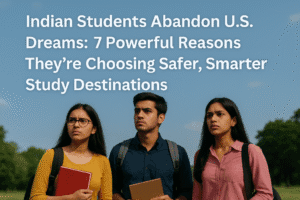Indian Students Abandon U.S. Dreams: 7 Powerful Reasons They’re Choosing Safer, Smarter Study Destinations
Growing uncertainty around U.S. visa policies—including revoked permits, SEVIS data deletions, and potential OPT program cuts—has driven Indian students to explore alternative study destinations. Countries like Germany, Ireland, France, and New Zealand are gaining traction for their affordable education, post-study work opportunities, and stable immigration policies. Germany’s engineering programs, with a 68% enrollment surge since 2022, and Ireland’s tech industry ties appeal to career-focused students.
New Zealand saw a 354% spike in applications, prioritizing safety and streamlined work visas, while France attracts business and design aspirants. Australia and the UK remain contenders with flexible visa pathways, though Canada faces setbacks due to housing shortages. Students now prioritize job-ready skills, cost-effectiveness, and long-term residency prospects over traditional rankings, signaling a strategic, data-driven approach to global education. This shift underscores a broader trend of diversifying aspirations in response to geopolitical and economic realities.

Indian Students Abandon U.S. Dreams: 7 Powerful Reasons They’re Choosing Safer, Smarter Study Destinations
A growing sense of uncertainty is reshaping the study-abroad aspirations of Indian students and their families. Recent changes in U.S. immigration policies—including visa revocations, abrupt deletions from the Student and Exchange Visitor Information System (SEVIS), and potential cuts to the Optional Practical Training (OPT) program—have fueled anxiety about America’s reliability as a top education destination. This unease, coupled with concerns over safety, political instability, and visa processing delays, is driving students to explore alternative countries that promise stability, affordability, and clearer pathways to post-study careers.
Why the U.S. Is Losing Its Allure
For decades, the U.S. dominated as the preferred choice for Indian students, particularly in STEM fields. However, recent policy shifts have eroded trust. The possible termination of the OPT program, which allows graduates to work for up to three years, threatens a major drawcard. Surveys indicate that 42% of international students now view the U.S. less favorably, citing bureaucratic hurdles and geopolitical tensions. “Students are weighing risks more carefully,” notes Aritra Ghoshal of OneStep Global.
Emerging Hotspots for Indian Students
As confidence in the U.S. wanes, countries like Germany, France, Ireland, New Zealand, and Australia are capitalizing on the opportunity to attract talent. Here’s what’s driving the shift:
- Germany: Engineering Excellence & Affordability
Germany’s reputation for cutting-edge engineering and applied sciences, paired with low or no tuition fees, has made it a magnet. Over 50,000 Indian students now study there—a 68% enrollment surge since 2022. The country’s robust job market and post-study work permits further sweeten the deal.
- Ireland: Tech Hub with Industry Links
Ireland’s thriving tech sector, anchored by giants like Google and Microsoft, offers unmatched opportunities in computer science and life sciences. Strong university-industry partnerships and English-speaking environments make it a pragmatic alternative.
- France & New Zealand: Niche Appeal
- France lures students with globally ranked business schools and design programs, along with streamlined visa processes.
- New Zealand has seen a staggering 354% rise in Indian applicants, driven by relaxed post-study work rules and perceptions of safety.
- Australia & Canada: A Mixed Landscape
While Australia remains popular for finance and healthcare, Canada faces headwinds due to housing shortages and visa delays. Recent caps on international student permits have pushed some toward European alternatives.
- The UK & Singapore: Strategic Pivots
The UK’s two-year Graduate Route visa and Singapore’s proximity to India, coupled with institutions like NUS, are drawing interest in business and tech fields.
Key Considerations for Students
Experts emphasize that the decision isn’t just about rankings anymore. Students are prioritizing:
- Post-Study Work Rights: Countries offering extended work permits (e.g., Germany’s 18-month job seeker visa) are rising in favor.
- Cost vs. ROI: Affordable tuition in Germany contrasts with steep U.S. fees, while New Zealand balances quality with lower living costs.
- Long-Term Stability: Immigration policies and safety now weigh as heavily as academic reputation.
The Road Ahead
While the U.S. retains its prestige in research and specialized fields like healthcare, the landscape is undeniably changing. “Students are making data-driven choices,” explains Gaurav Batra of Infinite Group, highlighting spikes in enrollment in non-traditional destinations like Russia (up 33.7%).
For families, the message is clear: diversification is key. As Manisha Zaveri of Career Mosaic advises, “Informed decisions—factoring in visas, job markets, and cultural adaptability—are critical to securing both academic and career success.”
In this era of geopolitical flux, Indian students are rewriting the playbook, proving that ambition and adaptability can turn global challenges into opportunities.
You must be logged in to post a comment.